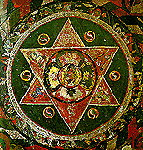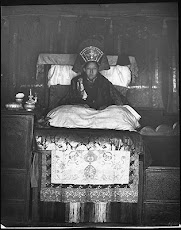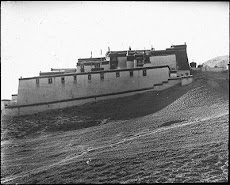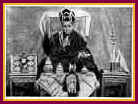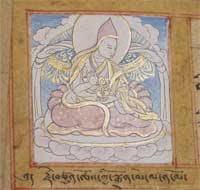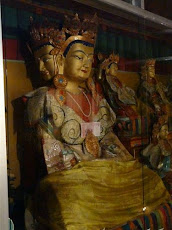sunnuntaina
A Tibetan woman lama and her reincarnations

Over the centuries, the significance of the Dorje Phagmo has grown through a process of ritualization that increased the distance between the people who worshipped her and the women who embodied her (for a detailed analysis of the process see Diemberger 2007. The following paragraphs are quoted from chapter 7).
Every girl who was recognized as the reincarnation of the Samding Dorje Phagmo went through a complex process managed by Samding monastery and religious authorities such as the Dalai Lama. The process of identification and training merged individual experience with the features of the deity and the memory of its previous historical incarnations. Some of the women came to embody the sacred persona in such a way that their individual identity almost disappeared as a simple name in the lineage, while others became significant personalities and scholars of their time over and above the sacredness attributed to them by their “office.” The Ninth Dorje Phagmo, for example, became a renowned spiritual master not only for Samding but also for the Nyingma tradition, discovered some terma, and died at Samye. Her skull is still preserved and worshipped as a holy relic in the Nyingmapa monastery on the island of Yumbudo in Yamdrog Lake. The current Dorje Phagmo has survived and maintained the tradition in a socialist context, adapting to the varied ways political and social practices have transformed and shaped contemporary Tibet during her lifetime.
The Twelfth Samding Dorje Phagmo, who is currently the head of Samding monastery, underwent the same process of identification as her predecessors, but her life experience has been unusually eventful. Born in 1938 in Nyemo, she has lived through the most dramatic events of modern Tibetan history, including the Chinese annexation of Tibet in 1951, the uprising in 1959, the Cultural Revolution, and the post-Mao era. As a religious leader she experienced both the extreme hardship of class struggle and the subtle ways prominent members of her class were co-opted as part of the modern political elite. She was included in the Chinese administration’s effort to integrate preexisting political and religious leaders of minority nationalities, a strategy that is usually defined as the United Front policy and takes its name from the organ of the Communist Party that has the specific task of dealing with the noncommunist elements of society. The Samding Dorje Phagmo was appointed to various positions in the Chinese People’s Political Consulting Conference (CPPCC) at both the regional and national levels in the 1950s and early 1960s, and again in the post-Mao era. In 1984 she became the vice president of the People’s Congress of the Tibet Autonomous Region (TAR); she was reconfirmed in this position in January 2003.
The Dorje Phagmo, as an institution, was transformed over the centuries to merge with the prevailing social and political climate, while retaining its distinctive spiritual tradition and the reincarnation lineage. The institution established with the death of the Gungthang princess was thus integrated in different political and religious frameworks: Bodongpa, Karmapa, Gelugpa, the Qing empire, and eventually the PRC. The last step was a huge leap and involved the transition from a Buddhist religious and political culture to a radically secular ideology: Chinese Communism. However, there are some surprising continuities with premodern political practices, for the United Front policy followed strategies that, in practice, had certain similarities with those of the Qing empire. Implemented by the Communist Party since its early days in order to secure control over Tibetan and Mongolian areas, the policy often required a process of negotiation with the local traditional leadership. This approach was important particularly in the 1950s and after Mao and tried to harness, strategically, the moral authority of the past within the modernist project of communist China. It is therefore possible to detect some remarkable continuities between premodern and modern Tibet, across the conventional divide between “old society” (spyi tshogs rnying pa) and “new society” (spyi tshogs gsar pa).
The Twelfth Samding Dorje Phagmo Admonishes the Dalai Lama
Here is a interesting news story from April 2008.
The Twelfth Samding Dorje Phagmo is Tibet’s only officially recognised female living Buddha. She was born in 1942 and was recognised at the age of five to be the incarnation of Vajravarahi, Dorje Phagmo, a female Buddha of enlightened wisdom who is the same nature as Vajrayogini.
Last year after the riots in Tibet, the Twelfth Samding Dorje Phagmo, who is the third most important Tulku in Tibet after the Dalai Lama and the Panchen Lama, and above Sakya Trizin, the head of the Sakya Tradition severely criticised the Dalai Lama, saying:
“The sins of the Dalai Lama and his followers seriously violate the basic teachings and precepts of Buddhism and seriously damage traditional Tibetan Buddhism’s normal order and good reputation,”
The article continues:
Samding Dorje Phagmo was quoted as saying – though she did not detail what his transgressions were.
I think we may have a good idea – maybe being a religious dictator by banning Dorje Shugden practice, causing a schism in the Sangha and generally causing Tibetan Buddhism to degenerate by mixing with politics?
Okay, this is old news but I didn’t realize its significance until today! Isn’t it quite surprising that such a high ranking Tulku should choose to criticise the Dalai Lama so harshly? But then again, she isn’t under his control and so she has the power to say what she thinks, unlike all the other reincarnate Tibetan Masters in India who have to fall in line with the Dalai Lama’s views or risk injury, harm or explusion from Tibetan society.
The Twelfth Samding Dorje Phagmo is Tibet’s only officially recognised female living Buddha. She was born in 1942 and was recognised at the age of five to be the incarnation of Vajravarahi, Dorje Phagmo, a female Buddha of enlightened wisdom who is the same nature as Vajrayogini.
Last year after the riots in Tibet, the Twelfth Samding Dorje Phagmo, who is the third most important Tulku in Tibet after the Dalai Lama and the Panchen Lama, and above Sakya Trizin, the head of the Sakya Tradition severely criticised the Dalai Lama, saying:
“The sins of the Dalai Lama and his followers seriously violate the basic teachings and precepts of Buddhism and seriously damage traditional Tibetan Buddhism’s normal order and good reputation,”
The article continues:
Samding Dorje Phagmo was quoted as saying – though she did not detail what his transgressions were.
I think we may have a good idea – maybe being a religious dictator by banning Dorje Shugden practice, causing a schism in the Sangha and generally causing Tibetan Buddhism to degenerate by mixing with politics?
Okay, this is old news but I didn’t realize its significance until today! Isn’t it quite surprising that such a high ranking Tulku should choose to criticise the Dalai Lama so harshly? But then again, she isn’t under his control and so she has the power to say what she thinks, unlike all the other reincarnate Tibetan Masters in India who have to fall in line with the Dalai Lama’s views or risk injury, harm or explusion from Tibetan society.
Samding Monastery

Situated on the southwest shore of Yamdrok Yumtso , the Samding Monastery is under the charge of the first female living Buddha in Tibet. Samding Dorje Phagmo, name of the living Buddha and her reincarnations, is known in Tibetan Buddhism as the avatar of Vajravarahi the Adamantine Sow, a female deity identified by a small sow's head emanating from the right side of her human head. To date there have been twelve Samding Dorje Phagmo reincarnations living in the monastery. The bodies of the former eleven reincarnations can be found at the monastery where they are still well preserved.
Some records show that the monastery was built by a student of Khyungpo Nyalior (978-1127), founder of the Shangpa Kagyu Sect, a branch of the Kagyupa School. Other records show that the monastery was built in 1441 by the first Samding Dorje Phagmo, student of Bodong Chokle Namgyel (1375-1451, founder of the Bodong Sect). Therefore, the Samding Monastery is considered to belong to the Bodong Sect. The monastery has been expanded from a small temple to an imposing building during the time of the second and fifth reincarnations of Samding Dorje Phagmo. The completed monastery consists of the Red Palace and the White Palace, which resemble the Potala Palace in Lhasa. For those who pay visits to Yamdrok Yumtso, a side trip to the monastery is very rewarding.
Female living Buddha condemns Dalai Lama - Xinhua
BEIJING (Reuters) - Tibet's only female living Buddha, who is also a top regional official, said she was upset and angered by riots in Lhasa last month, and accused the Dalai Lama of violating Buddhist teachings, state media reported.
The twelfth Samding Dorje Phagmo said that since Tibet's incorporation into Communist China it had been transformed from the backwards feudal society of largely illiterate serfs with little medical care that she knew as a child.
"Old Tibet was dark and cruel, the serfs lived worse than horses and cattle," she told the official Xinhua agency in an interview published on Tuesday.
Born in 1942, she was chosen as the incarnation of the deity Vajravarahi aged five. Now head of the Samding monastery, she is also vice-chairwoman of the standing committee of the Tibetan Autonomous Regional People's Congress, or regional parliament.
She was in Beijing for a meeting of a national consultative body to Parliament when rioting broke out in Lhasa on March 14, after days of monk-led protests.
"Watching on television a tiny number of unscrupulous people burning and smashing shops, schools and public property, brandishing knives and sticks to attack unfortunate passers-by I felt boundless surprise, deep heartache and indignant resentment," she said in the interview in Lhasa.
China has accused the Dalai Lama, Tibet's exiled spiritual leader, of plotting the riots and unrest that spread across many ethnic Tibetan parts of the country, in a bid to overshadow the summer Olympic Games and push for independence.
"The sins of the Dalai Lama and his followers seriously violate the basic teachings and precepts of Buddhism and seriously damage traditional Tibetan Buddhism's normal order and good reputation," the Samding Dorje Phagmo was quoted as saying -- though she did not detail what his transgressions were.
The Dalai Lama rejects China's claims, saying he supports the Olympic Games and seeks only greater autonomy for Tibet.
Beijing last week offered talks with his aides, after an international chorus urging dialogue. But state media continue to unleash a barrage of criticisms of the Dalai Lama or the Tibet he ruled before the arrival of Communist troops in 1950.
The twelfth Samding Dorje Phagmo said that since Tibet's incorporation into Communist China it had been transformed from the backwards feudal society of largely illiterate serfs with little medical care that she knew as a child.
"Old Tibet was dark and cruel, the serfs lived worse than horses and cattle," she told the official Xinhua agency in an interview published on Tuesday.
Born in 1942, she was chosen as the incarnation of the deity Vajravarahi aged five. Now head of the Samding monastery, she is also vice-chairwoman of the standing committee of the Tibetan Autonomous Regional People's Congress, or regional parliament.
She was in Beijing for a meeting of a national consultative body to Parliament when rioting broke out in Lhasa on March 14, after days of monk-led protests.
"Watching on television a tiny number of unscrupulous people burning and smashing shops, schools and public property, brandishing knives and sticks to attack unfortunate passers-by I felt boundless surprise, deep heartache and indignant resentment," she said in the interview in Lhasa.
China has accused the Dalai Lama, Tibet's exiled spiritual leader, of plotting the riots and unrest that spread across many ethnic Tibetan parts of the country, in a bid to overshadow the summer Olympic Games and push for independence.
"The sins of the Dalai Lama and his followers seriously violate the basic teachings and precepts of Buddhism and seriously damage traditional Tibetan Buddhism's normal order and good reputation," the Samding Dorje Phagmo was quoted as saying -- though she did not detail what his transgressions were.
The Dalai Lama rejects China's claims, saying he supports the Olympic Games and seeks only greater autonomy for Tibet.
Beijing last week offered talks with his aides, after an international chorus urging dialogue. But state media continue to unleash a barrage of criticisms of the Dalai Lama or the Tibet he ruled before the arrival of Communist troops in 1950.
Tilaa:
Blogitekstit (Atom)

